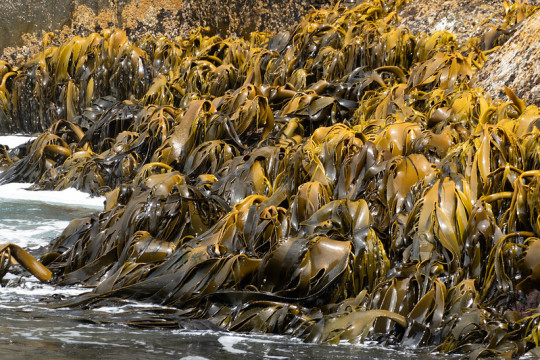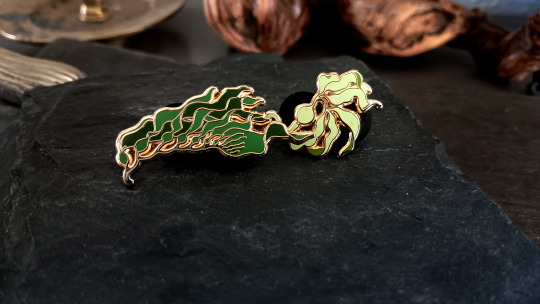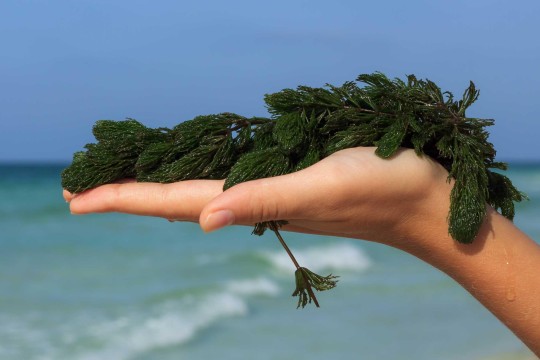#brown algae
Explore tagged Tumblr posts
Text


this jared is kelp
#yes technically not a plant i know#brown algae#gerard as plants#plant gee#mcr ecosystem#geecosystem#gee way#my chemical romance
52 notes
·
View notes
Text

Southern bull kelp (Durvillaea sp.) on the Tasman Peninsula, Tasmania, Australia
by John Turnbull
#southern bull kelp#kelp#seaweeds#brown algae#Durvillaeaceae#fucales#Phaeophyceae#gyrista#wildlife: australia#wildlife: oceania
271 notes
·
View notes
Text

[https://www.inaturalist.org/observations/63171461] Sliminess of the Skin || Trichodina domerguei Observed in France No Conservation Status
#algae#brown algae#plants#<- it is not but it is superficially similar. chlorophyll and all#nature#wildlife#photography#who cooks for queue? who cooks for queue all?
29 notes
·
View notes
Text










Algae of California (a tidepooling collection)
Surfgrass (Phyllospadix)
Sea Palm (Postelsia palmiformis)
Turkish Towel or close relative (Chondrocanthus)
CCA - Common Corraline? (Corallina officinalis)
The green genus that shows up everywhere (Cladophora)
Mystery red with potential carpospores
Iridescent algae? (Mazzaella)
Somebody red (Callophyllis)
Mystery red I’ve got no clue
My friend I love you - Dense Sea Fern (Neoptilosa Densa)
#phycology#algae#marine botany#seaweed#red algae#green algae#brown algae#last one is my favorite#I’m not familiar with California species so feel free to correct/provide IDs#I want to press number 10 and put her under a scope so much
32 notes
·
View notes
Text

Macrocystis pyrifera in Ensenada, Baja California.
53 notes
·
View notes
Text




Photos 1-4 - Sargassaceae sp.




Photos 5-8 - Turbinaria sp.


Photos 9-10 - unknown, possibly Chromista
Washed up brown algae (seaweed).
06/11/23 - Chromista spp. (iNaturalist uses this proposed grouping)
QLD:WET - Etty Bay
29 notes
·
View notes
Text


Cute kelp! I was pleasantly surprised these were common picks for freebies. I was kinda expecting that folks wouldn't be into it, but they were. Yey! I do think, I'd change the color on the bull kelp. I took artistic license with them being green as it is. Kelp is really more of a yellow color anyway. Brown algae after all. But I still think they come out nice~
15 notes
·
View notes
Text
@leebrontide hi!
Kelp is a type of brown algae (Phaeophyceae), which are protists. They may look like plants, but they sit in different parts of the family tree.
Eukaryotes phylogenetic tree:

Brown algae phylogenetic tree:

Kelp also have several physical characteristics such as blades, stipe, and holdfasts, which are analogous to leaves, stems, and roots of vascular plants but are a case of convergent evolution (like a shark and dolphin both having similarly shaped appendages!)

More importantly, all plants descend from a common ancestor that did primary endosymbiosis of that cyanobacteria way back when. Anything else that can do photosythenthesis and is not a cyanobacterium or a plant has an ancestor that has done secondary or tertiary endosymbiosis of an organism that already had chloroplasts.
Brown algae's ancestor took a red alga as an endosymbiot, and red alga is also a protist and thus did secondary endosymbiosis of a which is why their chloroplasts have four cellular membranes, whereas plants only have two:

So basically, plants and brown algae are wierdly related distant cousins cause one of them ate the other's grandpa or something like that.
Hope this kelps! 💚



the idea of protists is really funny. Ah yes, the kingdoms of life: Animals, Plants, Fungi, and Don't worry about it:)
#kelp#brown algae#phylogeny#evolutionary biology#eukaryotic endosymbiosis#plastids#protists are not a phylogenic grouping hehe haha#puns#long ass post that i made even longer lol#diatoms
24K notes
·
View notes
Text

TSRNOSS, p 596.
#theoretical biology#manuscript#satyendra sunkavally#ewes#mass spectrometer#lamb rejection#volatility of pheromones#secondary metabolites#brown algae#green turtle#Ascension island#monarch butterfly
0 notes
Text
#2748 - Marginariella boryana - Sawtoothed Comb


Endemic to Aotearoa, including the Chathams.
Found from the low intertidal to subtidal zones on rock on exposed coasts, and in deeper water in sheltered areas. It grows to about 2 meters in length, and the stipes are usually 1-3cm wide but can be up to 10cm in sheltered waters.
There are three species in the genus, 2 which grow from Cook Strait south and one from the Antipodes and Bounty Islands.
Dunedin, Aotearoa New Zealand
0 notes
Text
Seaweed in Skincare: Benefits and Best Products
The beauty world is constantly seeking natural, potent ingredients to enhance skin health, and seaweed has emerged as a powerhouse. Packed with nutrients, antioxidants, and hydration-boosting properties, seaweed has been used for centuries in traditional skincare routines. From reducing inflammation to boosting collagen, this ocean-derived ingredient offers a wide range of benefits. Let’s dive…
#anti-inflammatory#antioxidants#boosts collagen#brown algae#deep hydration#detoxifying#green algae#purifying#red algae#seaweed in skincare
0 notes
Text
Exploring the Magic of Alginate Impression Materials and Hand Spatulation in Dental Practice
In the world of dentistry, precision is paramount. Whether it's crafting a crown, fabricating dentures, or creating a nightguard, the first step often involves taking an accurate impression of the patient's teeth and surrounding tissues. Enter alginate impression materials—a staple in every dental office's arsenal.
#Alginate#alginate powder#art of hand spatulation#brown algae#brown seaweeds#dental impressions#ice cream#modern dentistry#prosthetics#restorations#sodium alginate
0 notes
Text

Heterokonta, el reino naranja
Los heterocontos o estramenopilos (Stramenopiles) son uno de los grupos con mayor diversidad de especies. Podemos encontrar tanto organismos unicelulares como pluricelulares abarcando varios nichos. Una característica de la mayoría de las especies de este grupo en al menos alguna de las etapas de sus ciclos vitales es la presencia de dos flagelos diferenciados, uno con mastigonemas (proyecciones similares a cerdas de cepillos) y otro liso y menos desarrollado.
Dentro de los Heterocontos podemos encontrar organismos autótrofos unicelulares como son las diatomeas (Bacillariophyceae), las cuales pueden encontrarse flotando sobre la columna de agua (planctónicos) o en el lecho de los cuerpos de agua (bentónicos) y pluricelulares como feofíceas (Phaeophyceae) llamadas comúnmente algas pardas. Algunas de ellas, tales como Laminaria sp. se encuentran sujetas al sustrato, un caso similar pasa con Macrocystis sp., con la única diferencia de que esta cuenta con neumatocistos en la base de sus láminas, estas estructuras le ayudan con la flotabilidad, manteniéndola erguida. Ambas especies conforman los denominados bosque de kelp. Por otra parte, algunas especies de feofíceas como el sargazo (Sargassum sp) se encuentran flotando libremente gracias a los neumatocistos con los que cuenta.
Una característica muy llamativa que presentan los heterocontos autótrofos es la presencia de clorofila a y c,la cual se cree que es producto de la fagocitación y endosimbiosis de los cloroplastos de las algas rojas en algún momento de su historia evolutiva.
Por otro lado, podemos encontrar organismos heterótrofos como los Opalinos (Opalinata) donde encontramos a Protoopalina, los cuales son comensales dentro de los intestinos de algunos organismos como anfibios o reptiles y también organismos saprofitos y parásitos como son los Oomicetos (Oomycetes), organismos morfológica y ecológicamente similares a los hongos pero que no guardan ninguna relación con ellos, como es el caso de Peronospora sp.
La reproducción en estas especies puede ser tanto asexual como sexual y en el caso de las feociceas se presenta la alternancia de generaciones, es decir, que las formas haploides y diploides son pluricelulares y de vida libre.
Referencias citadas
Álvarez, A. R. (2006). Los protozoos. Características generales y su rol como agentes patógenos. Ciencia Veterinaria Vol. 8, Nº 1. pp 62-71. Los protozoos: características generales y su rol como agentes patógenos | Ciencia Veterinaria (unlpam.edu.ar)
Derelle R, López-García P, Timpano H, Moreira D. A Phylogenomic Framework to Study the Diversity and Evolution of Stramenopiles (=Heterokonts). Mol Biol Evol. 2016 Nov;33(11):2890-2898. doi: 10.1093/molbev/msw168. Epub 2016 Aug 10. PMID: 27512113; PMCID: PMC5482393. A phylogenomic framework to study the diversity and evolution of stramenopiles (=heterokonts) - PMC (nih.gov)
Cavalier-Smith T. Kingdom Chromista and its eight phyla: a new synthesis emphasising periplastid protein targeting, cytoskeletal and periplastid evolution, and ancient divergences. Protoplasma. 2018 Jan;255(1):297-357. doi: 10.1007/s00709-017-1147-3. Epub 2017 Sep 5. PMID: 28875267; PMCID: PMC5756292. Kingdom Chromista and its eight phyla: a new synthesis emphasising periplastid protein targeting, cytoskeletal and periplastid evolution, and ancient divergences - PMC (nih.gov)
Atlas of Living Australia. Heterokonta | Atlas of Living Australia (ala.org.au)
Filo Oomycota - Clase Oomycetes. Myco-UAL. Universidad de Almeria. Principales grupos fúngicos - Oomycota (ual.es)
Okolodkov, Y. B. y Huerta-Quintanilla, D. A.(2018). Diatomeas bentónicas marinas. Materia, Ciencia y Nanociencia 1:2. pp. 13-18
A2-Diatomeas-bentonicas-marinas1.pdf (uv.mx)
Wehr, J. D. (2015). Brown algae. In Freshwater Algae of North America (pp. 851-871). Academic Press. 10.1016/B978-012741550-5/50023-4. (12) (PDF) Brown Algae (researchgate.net)
“Ciclos de vida sexual. Tipos de ciclos de vida sexual: diploide dominante, haploide dominante y alternancia de generaciones”. Khan Academy, accedido 01.31.2024. Ciclos de vida sexual (artículo) | Meiosis | Khan Academy
Nabors, M. W. (2006). Introducción a la botánica (P. González-Barreda), Pearson (Obra original publicada en 2004).
0 notes
Text



#marine biology#marine life#phycology#limu haul#herbarium daily#herbarium#digital herbarium#dictyota#dictyota acutiloba#tropical algae#brown algae
29 notes
·
View notes
Text
Algae Extract for Skin: Benefits, Easy DIY and How it Works

Welcome to the world of skincare innovation! Today, we’re diving deep into the rejuvenating secrets of “algae extract for skin.” Are you curious about how these oceanic wonders can transform your complexion? Join us as we explore the natural treasures of the sea and unlock the potential for healthier, radiant skin.
In the ever-evolving world of skincare, where beauty enthusiasts are increasingly turning to nature for holistic solutions, one ingredient has garnered significant attention: algae extract.
Algae, often associated with aquatic ecosystems, might not be the first thing that comes to mind when thinking about skincare, but its potential benefits for the skin are making waves in the beauty industry.
As the demand for natural and sustainable skincare options continues to rise, algae extract has emerged as a promising ingredient due to its unique properties and diverse applications.
As you are about to dive into the world of algae extract for skincare, explore what it is, its numerous benefits, how it works on the skin, and how you can incorporate it into your daily routine.
Whether you’re a skincare aficionado or simply curious about the latest trends in beauty, read on to discover the secrets of harnessing the power of algae for healthier, more radiant skin.
What is Algae Extract?
Algae extract is a natural skincare ingredient derived from various types of algae, which are simple, photosynthetic aquatic organisms.
While algae might conjure images of slimy seaweed on the ocean floor, these versatile organisms have been harnessed for their beneficial properties in the world of skincare.
There are three primary types of algae used in skincare:
Green Algae: These include popular varieties like Chlorella and Spirulina. Green algae are rich in chlorophyll and essential fatty acids, making them excellent for nourishing and revitalizing the skin.
Brown Algae: Fucus vesiculosus (commonly known as bladderwrack) and laminaria are examples of brown algae used in skincare. They are prized for their hydrating and antioxidant properties.
Red Algae: Carrageenan and agar-agar are derived from red algae. They are known for their ability to soothe and protect the skin, making them valuable in sensitive skin formulations.
For more information, Click Here: Algae Extract for Skin
#theskinpanda#skincare#skincare routine#skincare tips#skin tightening#dark skin#acne#diy skincare#algae#green algae#algae bloom#brown algae#red algae#algae benefits for skin#algae extract for skin
1 note
·
View note
Text




Peacock's tail brown algae. Another common sight in tidepools.
06/11/23 - Phaeophyceae: Padina pavonica
QLD:WET - tidepools
9 notes
·
View notes